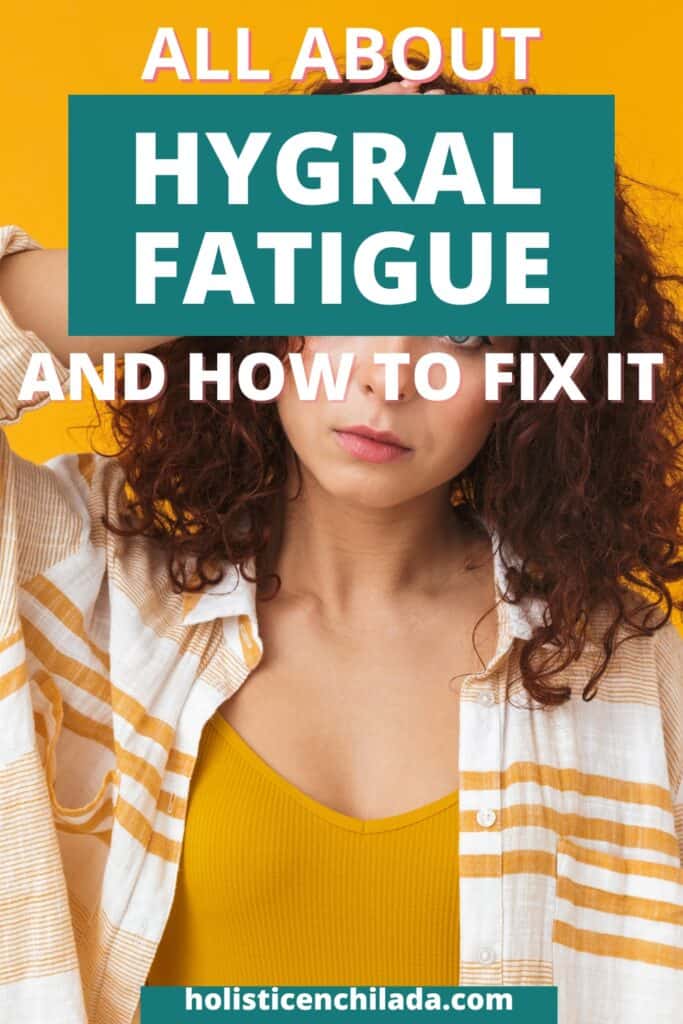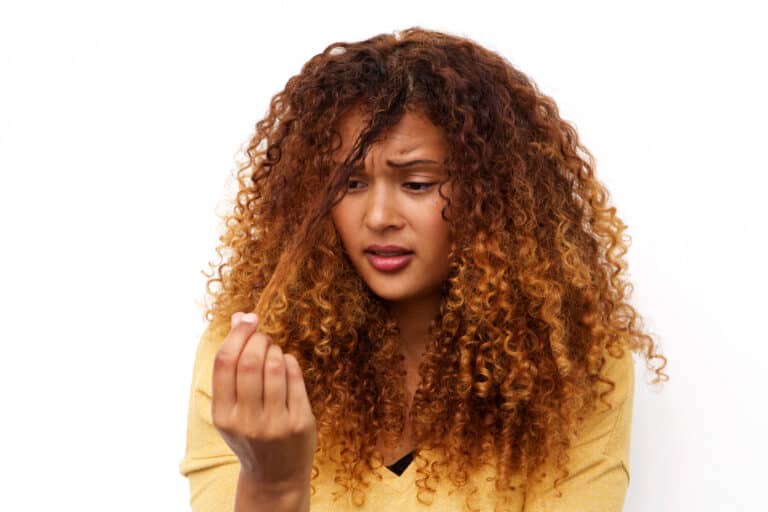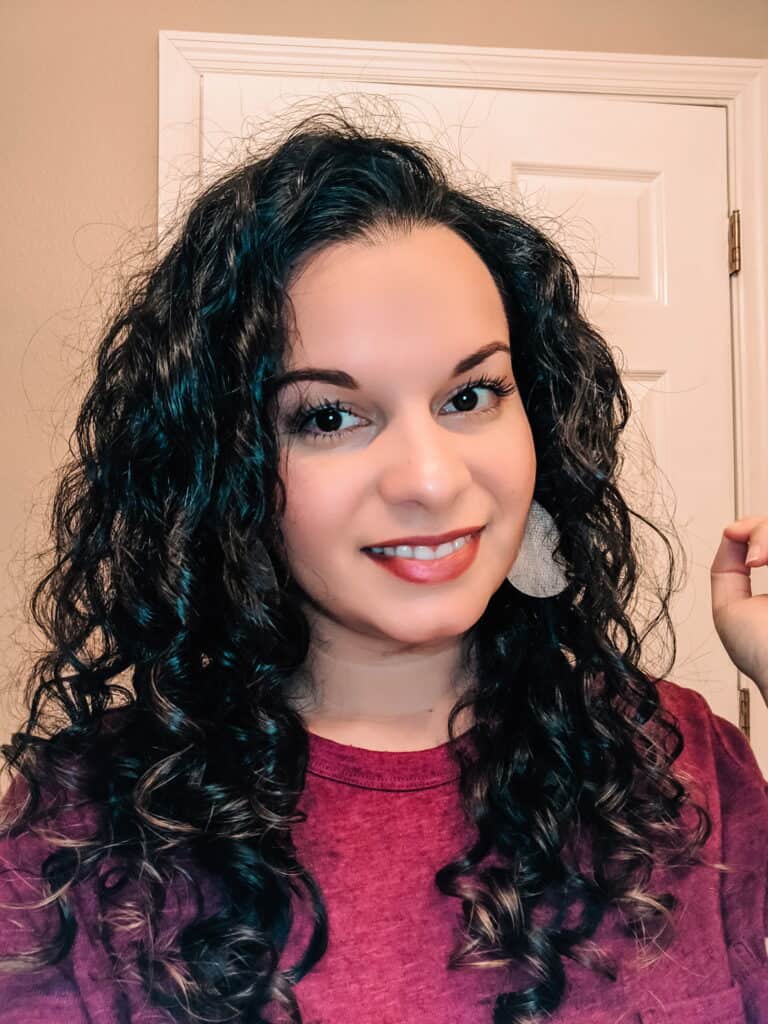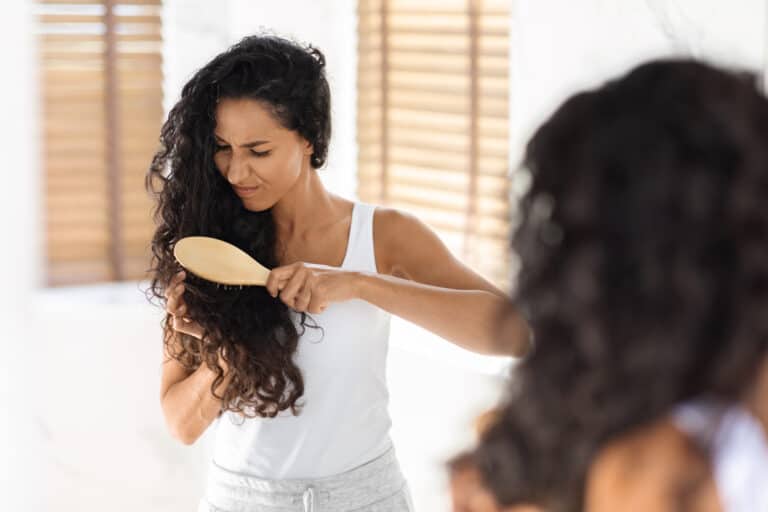Hygral Fatigue: Solve Your Hair Troubles
This post may contain affiliate links, and I will earn a commission if you purchase through these links. Please read the disclosure policy for more details.
Everyone knows that healthy hair needs plenty of moisture. But if your hair absorbs too much moisture, it could lead to hygral fatigue.
You may not have heard of hygral fatigue before. It’s a condition that can lead to your curly hair losing elasticity, looking limp and lifeless, and eventually breaking.
The causes of hygral fatigue vary, but the good news is it can easily be resolved if you catch it in the early stages. This means it’s essential to know the signs of hygral fatigue so you can act quickly when you see them.
This guide will tell you everything you need to know about hygral fatigue, including what causes it, the signs of hygral fatigue and how to fix hygral fatigue.
Hygral Fatigue: What Is It?
When excess moisture repeatedly enters and exits your hair cuticles, it can cause the hair strands to swell and shrink. But your hair isn’t designed to change size repeatedly like this.
If your hair doesn’t have a strong protein structure, the repeated swelling and shrinking will damage your cuticles, which is called hygral fatigue. Like an elastic band being stretched repeatedly, it leads to your damaged hair losing elasticity and eventually breaking.
Hygral fatigue is often associated with hair porosity, but everyone’s hair is unique. Learning the causes and symptoms of hygral fatigue will help you recognize it in your own hair.

Recognizing Symptoms of Hygral Fatigue
There are several stages of hygral fatigue, and spotting the symptoms as soon as possible is vital to avoid the worst hair damage. Here are some of the key signs of hygral fatigue:
Poorly Defined Curls or Frizziness
Curly hair with hygral fatigue struggles to maintain its curl structure and the curls become poorly defined. The hair will feel light, and there may be excess frizz, tangles, and knots.
Dull and Limp Hair
Hair that is experiencing hygral fatigue will feel limp and brittle, and look dull and lifeless.
Gummy Texture when Wet
Without the proper protein structure to support it, your hair will have a gummy feeling when it’s saturated with water.
Low Elasticity
Hair with hygral fatigue may have low elasticity. This means it’s difficult to stretch when wet or doesn’t spring back when you’ve stretched it out.
You can test this by performing the wet stretch test. If you gently stretch a strand of wet hair, it should return to its original length easily and without breaking.
If it doesn’t stretch much, you probably need to add moisture to your hair, but if your hair stretches too far and then breaks, it probably needs more protein.
Breakage
Severe hygral fatigue may lead to breakage as the weakened protein structure of your hair struggles to support the weight of water absorbed into the strands. Remember that other factors like rough shampooing or excessive tangles could also cause hair breakage.
Causes of Hygral Fatigue Hair
There are several potential causes of hygral fatigue, and some or all of these might affect your hair. Here are some factors that may cause hygral fatigue:
Over Moisturized or Over Hydrated Hair
Overusing moisturizing products can leave hair at risk of hygral fatigue, particularly in high porosity hair. Using a deep conditioner or hair mask too often or letting deep conditioner sit on your hair for too long can also be a risk factor. Leaving your hair soaking wet for too long after your shower or constantly wetting hair before it has dried completely will also risk hygral fatigue.
Loss of Necessary Oils in Hair
Hair naturally repels water thanks to an oily substance called 18-MEA (18-metil eicosanoic acid) which coats the cuticle surface of your hair strands.
This protective substance can be stripped from your hair by frequent shampooing or using chemical processes like dyes or perms regularly. Without the 18-MEA layer, the cuticles can open up, allowing more moisture to enter the hair shafts.
Damage to Hair
Chemical treatments, environmental factors, heated styling tools, or harsh grooming can damage the protective cuticle cells on your hair strands, making your hair more porous.
Imbalanced pH Levels
The pH level of your hair measures how acidic or alkaline it is. On a scale from 1 (very acidic) to 14 (very alkaline), healthy hair tends to be around pH 5.5.
Using alkaline products on your hair can remove the protective 18-MEA layer and cause friction between hair fibers, damaging the hair’s cuticle layer.
Genetic Causes
If you have low hair porosity, the hair cuticle cells are tightly packed together, which makes it more difficult for water to be absorbed. If you have high porosity hair, it’s easier for water to enter the hair because the cuticle cells are spaced further apart.
So if you know that you have high hair porosity, it’s even more important to try and avoid hygral fatigue.
If you’re unsure whether you have high or low porosity hair, you can learn more in our Ultimate Guide to Hair Porosity.
How to Prevent Hygral Fatigue
Prevention is better than cure, so preventing hygral fatigue is the best option for healthy hair. Here are a few simple steps you can take:
Brushing
If you have a wavy or curly hair type, use a wide-toothed comb to brush your hair while it is still wet. This will distribute moisture and minimize any damage that may be caused. Straight hair should only be brushed or combed when dry to avoid stretching and damage.
Pre-Wash
A pre-poo or pre-wash treatment containing coconut oil can help prevent hygral fatigue.
Coconut oil is thought to penetrate the hair shaft easier than other oils, allowing it to attach to the hair’s protein structure and reduce swelling in the hair cuticle.
If your hair doesn’t get on well with coconut oil, try olive oil or avocado oil instead.
PH Balanced Products
A low pH shampoo (around pH5.5) may also help to balance the pH of your hair and prevent the breakdown of the protective 18-MEA layer of the hair cuticle. This will help close the cuticles on high-porosity hair, which reduces the amount of water that can be absorbed.
Drying
Removing excess water from your hair after washing is important, but avoid cotton towels that risk tangling and stretching your curls. Instead, use a microfiber towel or cotton t-shirt to remove the water weight and reduce the movement of your hair cuticles.
Stop Over-Conditioning
Avoid over-conditioning your curls by limiting the time your hair spends drenched in water or conditioning products. A deep conditioner or hair mask should not be left on for longer than 30 minutes, and afterwards, you can seal in the moisture with a high-quality leave-in conditioner.
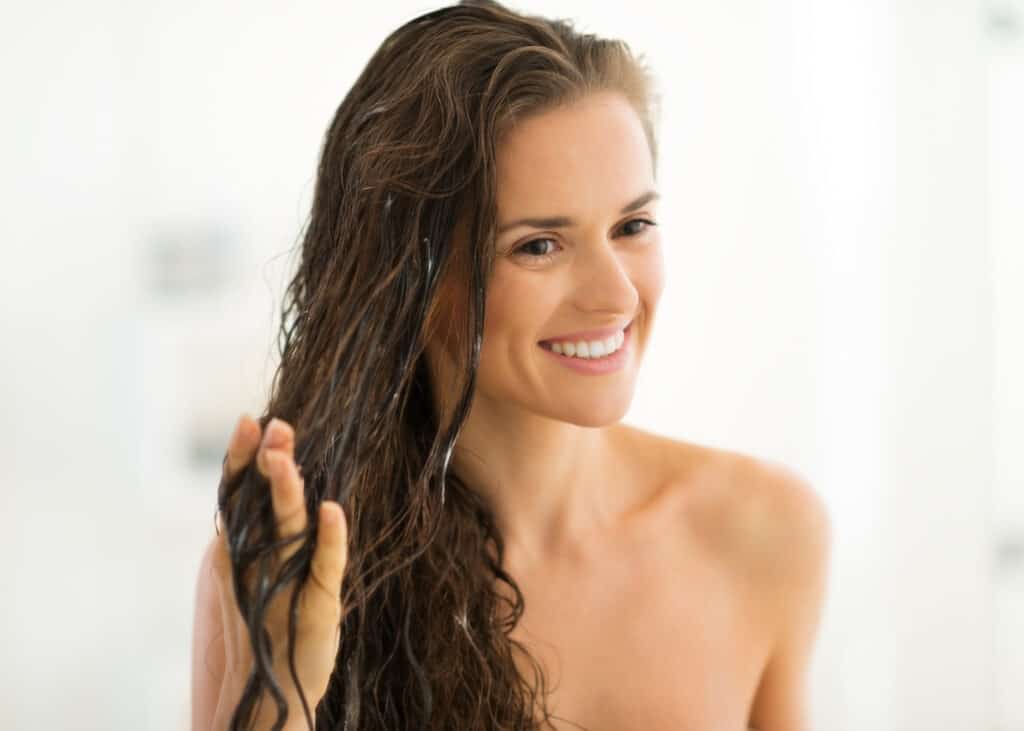
Treatments to Correct Hygral Fatigue Issue
Hygral fatigue damage can’t be reversed, and hair affected by it will be at risk of further damage. So it’s best to minimize future damage while you wait for the damaged hair to be replaced by new healthy hair.
Use Protein-Rich Treatments
Strengthening the protein structure of the hair shaft through proper conditioning will minimize damage, by preventing the hair shaft from absorbing water and swelling. You will need trial and error to work out how your hair reacts to protein treatments and how often you need to use them.
Find recommendations on protein treatments in Protein Treatments For Curly Hair.
Remove Damaged Hair
Because your hair can’t heal itself as your skin can, there is only so much you can do to repair the damage. Over time, healthy hair will replace the damaged strands. If you have severe hygral fatigue and your hair has started to develop split ends, cutting them out will prevent them from getting worse and causing damage in healthy sections of hair.
Read more: The Ultimate Guide to Getting A Curly Cut
Try Coconut Oil
Coconut oil can bind to the hair’s natural protein structure, helping to reduce the absorption of water and making the hair fiber stronger. This makes it particularly useful to minimize the damage from regular chemical treatments like hair colors and perms or frequent use of blow dryers and hot styling tools.
Read more: How To Use Coconut Oil For Curly Hair
Switch Your Hair Products
It’s best to avoid using moisturizing shampoos and conditioners on hair with hygral fatigue. You might also want to wash your hair less often to avoid stripping the natural protective oils from your hair strands.
Using a pre poo treatment containing coconut oil containing coconut oil before a sulfate-free shampoo will gently cleanse your hair without adding too much moisture. You can then follow up with a protein-rich conditioner to support the protein structure of your hair fibers, and apply a protein-rich leave-in conditioner if desired.
Minimize Other Damage
Avoiding other sources of damage may help to prevent your hair cuticle from breaking down any further. This may include:
- Chemical treatments like perms or hair straightening
- Frequent use of hair colors
- Vigorous shampooing and towel drying
- Blow drying and hot styling tools in your styling routine
- Chlorine in swimming pool water
Try to reduce the length of time that your hair is soaking wet in the shower or when you use overnight treatments. You can also prevent your wet hair from contracting too much as it dries by sealing it with an oil treatment after styling.
Best Products to Treat Hygral Fatigue
The best product for your hair will depend on factors like hair porosity and how severe the damage is. Here are some suggested products to try:
Minimal or light breakage
This is usually easy to fix with a light protein-based conditioner, leave-in conditioner or a single deep conditioner treatment:
- ApHogee Intensive Two Minute Keratin Reconstructor
- AVEDA Damage Remedy Intensive Restructuring Treatment

We earn a commission if you make a purchase, at no additional cost to you.

We earn a commission if you make a purchase, at no additional cost to you.
Moderate breakage
Use a mild-protein reconstructing product once or twice a week, depending on the level of damage, until your hair is restored:
- ApHogee Intensive Two Minute Keratin Reconstructor

We earn a commission if you make a purchase, at no additional cost to you.
Advanced or severe breakage
Add a coconut oil pre poo and an intense-protein reconstructor into your wash day routine:
- Avlon Affirm 5 In 1 Reconstructor
- Aphogee Two-step Treatment Protein for Damaged Hair

We earn a commission if you make a purchase, at no additional cost to you.

We earn a commission if you make a purchase, at no additional cost to you.
A clarifying shampoo treatment will also help to improve protein absorption by removing traces of product from your hair:
- Kinky Curly Original Hair Care Come Clean Clarifying Shampoo
- MopTop Detox Shampoo
- Bumble and Bumble Sunday Shampoo

We earn a commission if you make a purchase, at no additional cost to you.

A light clarifying shampoo for all hair types.
Use code HE10 to save at MopTop.com.
We earn a commission if you make a purchase, at no additional cost to you.

We earn a commission if you make a purchase, at no additional cost to you.
Hygral Fatigue Before and After
Check out the videos below of others who have had hygral fatigue and fixed it. Learn more about how they overcame it and what the process was like.
FAQs
If you still need more information about hygral fatigue, here are some of your most-asked questions about the condition:
How Long Does Balancing Hygral Fatigue Take?
There’s no set length of time for repairing your hair, as it depends on the condition of your hair. You might find that some sections recover faster than others, and you might have to repeat the regimen a few times before your hair is balanced again.
Is Overly Moisturized Hair the Same as Hygral Fatigue?
Some people use over-moisturized, over-conditioned, and hygral fatigue interchangeably. However, while over-conditioning and over-moisturizing both mean excessive use of moisturizing conditioners or hair oils, hygral fatigue is due to too much water in the hair.
Will Any Hair Treatments or Masks Resolve Hygral Fatigue Symptoms?
If your hair lacks a strong protein structure, using a protein-rich conditioner may help to prevent or treat hygral fatigue symptoms. The type of product you need to use will depend on how severe the symptoms are.
How Do You Keep Your Hair pH Balanced?
Shampoos can often strip the protective 18-MEA layer from your hair strands, causing your hair to be more porous. You can balance your hair pH by using a low-pH shampoo, which may prevent damage to the 18-MEA layer.
The Bottom Line
Hygral fatigue is the damage that occurs when excessive moisture is absorbed by your hair causing it to repeatedly swell and shrink. It can lead to hair losing elasticity, looking dull, and eventually breaking.
While high-porosity hair might be more likely to experience hygral fatigue, it is possible to prevent it from damaging your hair.
If you pay close attention to your hair and catch hygral fatigue early, it is possible to minimize the damage. You can restore your hair to its beautiful best by using the right products, good hair care, and a little patience.
Sources
- Hair Cosmetics: An Overview – National Library of Medicine
- Hair Swelling in Water – Science-y Hair Blog
- Effect of mineral oil, sunflower oil, and coconut oil on prevention of hair damage – Journal of Cosmetic Science
- The Science of Hair Care
- Hair cosmetics: An overview – International Journal of Trichology
- The shampoo pH can affect the hair: Myth or Reality? – International Journal of Trichology
Please do me a favor and share this post to social media, as it helps me grow my audience and spread the word about our curly hair movement! And remember to subscribe to my YouTube Channel for more curly hair tips and product recommendations. Thanks!
Want To Remember This? Save Hygral Fatigue: Solve Your Hair Troubles To Your Favorite Pinterest Board!
